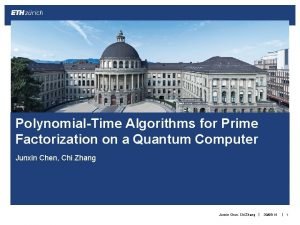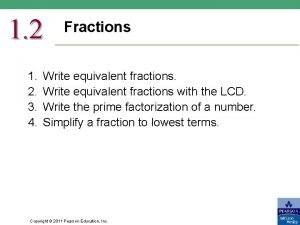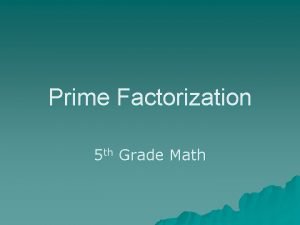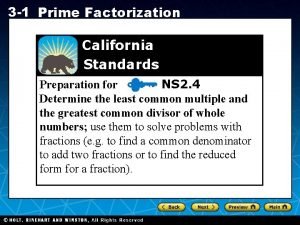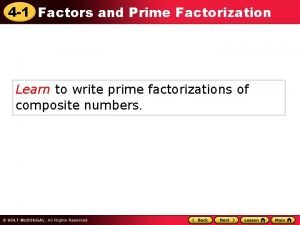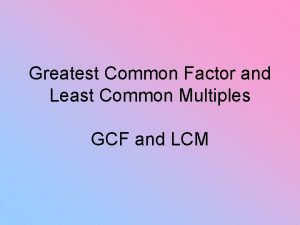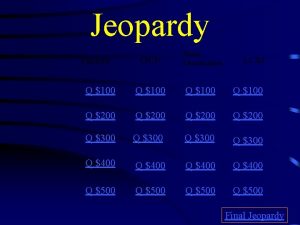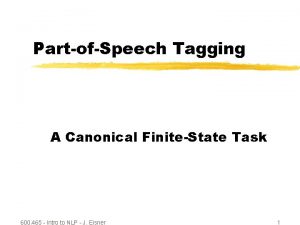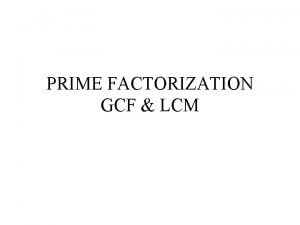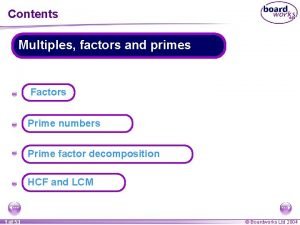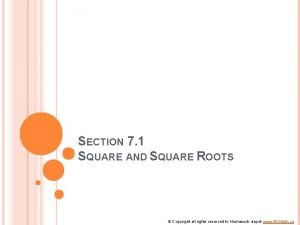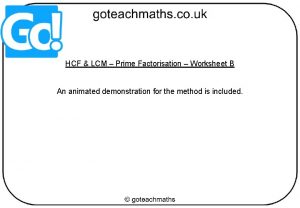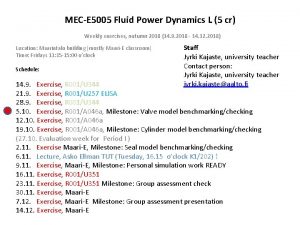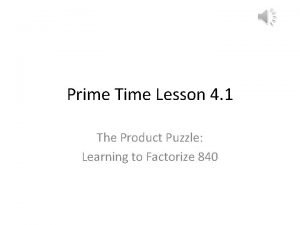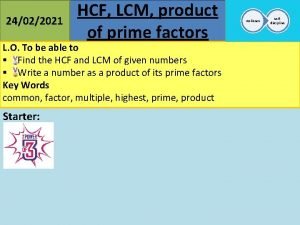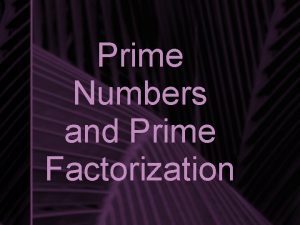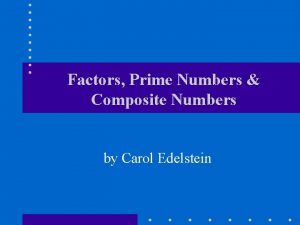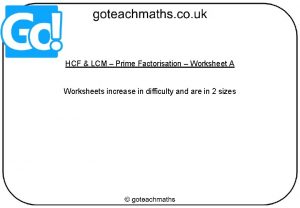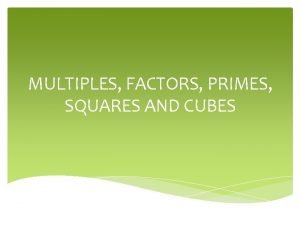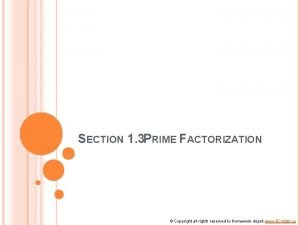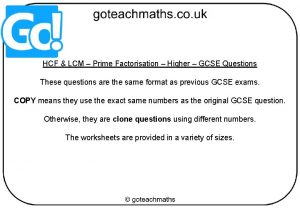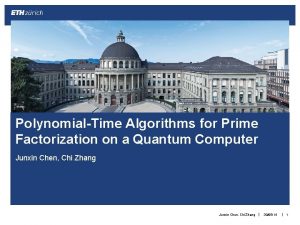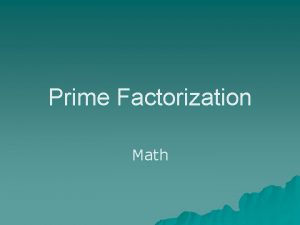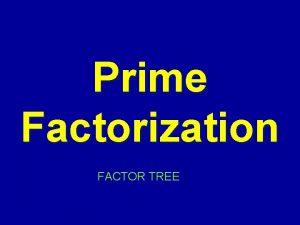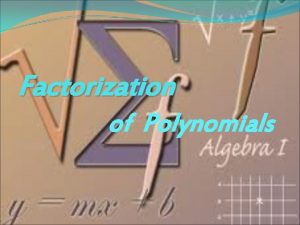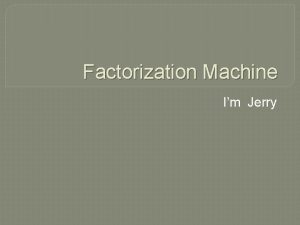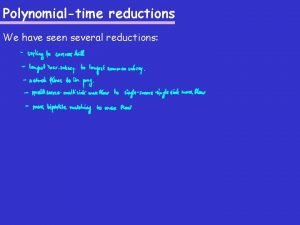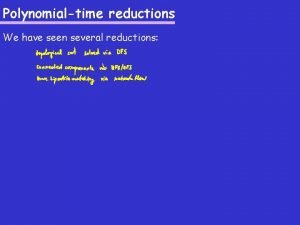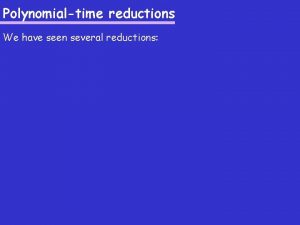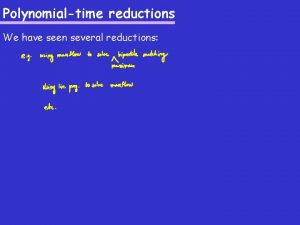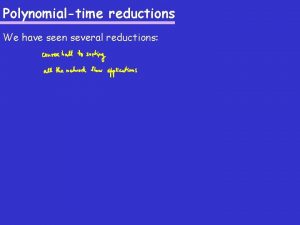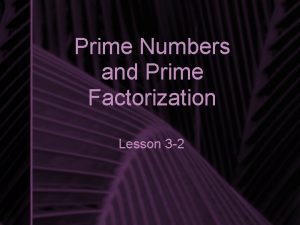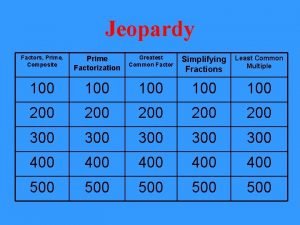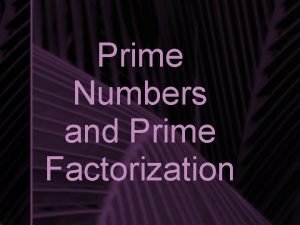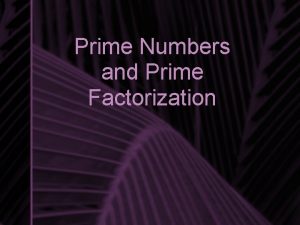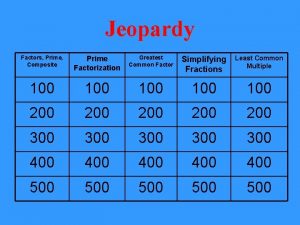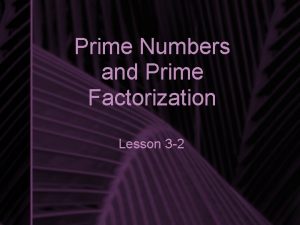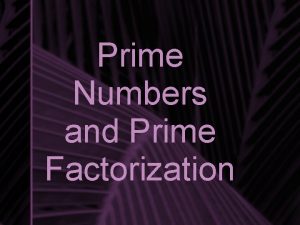PolynomialTime Algorithms for Prime Factorization on a Quantum

































- Slides: 33

Polynomial-Time Algorithms for Prime Factorization on a Quantum Computer Junxin Chen, Chi Zhang | 30/05/14 | 1

Outline § Introduction § Order-finding Algorithm § § Superposition State Preparation Modular Exponentiation Quantum Fourier Transform Measurement and Estimating r § Example: Factorizing 21 § Summary ((Vorname Nachname)) | 06. 03. 2021 | 2

Why Shor’s Algorithm interesting? § RSA Encryption Breaking RSA encryption requires prime factorizing a large integer (M) Best classical algorithm: Shor’s algorithm: Image source: http: //www. lsi-contest. com/2008/spec 2_e. html ((Vorname Nachname)) | 06. 03. 2021 | 3

What is special for quantum algorithm? § Parallelism – Use of superposition states § Reversibility – Due to unitary operators § Special requirements: § Need additional output to keep track of the input § In intermediate steps, the additional output may need to be erased “reversibly” Junxin Chen, Chi Zhang | 30/05/14 | 4

Procedure of prime factorization Junxin Chen, Chi Zhang | 30/05/14 | 5

Quantum Order-finding Algorithm Input: (x, n); Output: order r Prepare Superposition q : total number of states, integer power of 2 Modular Exponentiation QFT Measurement and estimate order r Junxin Chen, Chi Zhang | 30/05/14 | 6

Prepare Superposition State Goal: Junxin Chen, Chi Zhang | 30/05/14 | 7

Prepare Superposition State H H … First Register L qubits H Second register not changed Junxin Chen, Chi Zhang | 30/05/14 | 8

Modular Exponentiation Goal: Junxin Chen, Chi Zhang | 30/05/14 | 9

Modular Exponentiation Register a Register power … … result b c Junxin Chen, Chi Zhang | 30/05/14 | 10

Modular Exponentiations Register b Register result … … We do not want b in the final result! One more step to go… Junxin Chen, Chi Zhang | 30/05/14 | 11

Modular Exponentiation Register b Register result … … Bonus: quantum watchdog Junxin Chen, Chi Zhang | 30/05/14 | 12

Modular Exponentiation Junxin Chen, Chi Zhang | 30/05/14 | 13

Quantum Fourier Transform Goal: Junxin Chen, Chi Zhang | 30/05/14 | 14

Quantum Fourier Transform § Definition of Fourier Transform § Quantum version Junxin Chen, Chi Zhang | 30/05/14 | 15

Quantum Fourier Transform § With a little algebra, quantum Fourier transform can be written into such a product representation binary representation of For deduction, see Nielson & Chuang, P 218 Junxin Chen, Chi Zhang | 30/05/14 | 16

Quantum Fourier Transform § Ingredients § Hadamard Gate H § Controlled Phase Gate Rk R 2 Junxin Chen, Chi Zhang | 30/05/14 | 17

Quantum Fourier Transform R 2 … H Rl-1 Rl … H Rl-2 Rl-1 … H R 2 H Junxin Chen, Chi Zhang | 30/05/14 | 18

Quantum Fourier Transform § Compare the output of the above circuit § With the definition of Quantum Fourier Transform § Use at most l/2 swap gates to change the order § Read in reverse order Junxin Chen, Chi Zhang | 30/05/14 | 19

Measurement and Estimating r § Goal: § Measure the state of the two registers § Estimate r from the measured state Junxin Chen, Chi Zhang | 30/05/14 | 20

Measurement and Estimating r Final state: Has a probability to get Junxin Chen, Chi Zhang | 30/05/14 | 21

Measurement and Estimating r § Probability § Because the order of x is r, this sum is over all a satisfying residue congruent to rc (mod q) Junxin Chen, Chi Zhang | 30/05/14 | 22

Measurement and Estimating r § Probability § Only when is close to 0, the probability would be significant § We can conclude our measurement of c is very likely to be an integer multiple of r/q § Therefore r can be estimated using classical computer Junxin Chen, Chi Zhang | 30/05/14 | 23

Example: Factorizing 21 § First, choose a random integer in the range (1, 20) § Extremely lucky: x=3 § We are done! gcd(3, 21) = 7, and 3× 7 = 21 § Quite lucky: x=9 § gcd(9, 21) = 3 and we get another prime factor by calculating 21 ÷ 3 = 7 § Unlucky: x = 10 § gcd(10, 21) = 1 § Therefore we need to run the quantum order-finding routine! Junxin Chen, Chi Zhang | 30/05/14 | 24

Example: Factorizing 21 Initial states: Superposition states: … Junxin Chen, Chi Zhang | 30/05/14 | 25

Example: Factorizing 21 § Modular Exponentiation Period of 6 Note: No tensor product here. They are entangled states! Junxin Chen, Chi Zhang | 30/05/14 | 26

Example: Factorizing 21 § Quantum Fourier Transform § Measurement § Suppose the output of the second register is 19 § We need to collect all the possible a, such that ? ? ? Junxin Chen, Chi Zhang | 30/05/14 | 27

Example: Factorizing 21 § Measurement § Probability amplitude to get a value c in the first register: 512 (0) 256 85 171 341 427 The measurement output of first register will most probably be one of the 6 numbers. Let’s assume we get 341… Junxin Chen, Chi Zhang | 30/05/14 | 28

Example: Factorizing 21 § Estimate r § Check if r=3 correct? No… § Run the order-finding program again with input x=103(mod 21), to get another factor of r, which is 2. Therefore r=2× 3=6 § Or make some trials based on r 1=3, with classical computer § Get correct answer r=6 Junxin Chen, Chi Zhang | 30/05/14 | 29

Example: Factorizing 21 § Now we know r=6 § r is even § 103+1(mod 21)= 14, does not equal to 20 § Good choice! § gcd(103+1, 21)=7 § gcd(103 -1, 21)=3 § We are done! Junxin Chen, Chi Zhang | 30/05/14 | 30

Summary § Only polynomial time needed for Shor’s algorithm. Exponential time need classically. § Procedure of Shor’s algorithm: § § Prepare superposition states Modular exponentiation Quantum Fourier transform Measure the register. Estimate the order r using classical computer. § Quantum parallelism makes Shor’s algorithm faster than classical ones, but requirement for reversibility makes it more complicated than classical. Junxin Chen, Chi Zhang | 30/05/14 | 31

Literature § Shor, Peter W. "Polynomial-time algorithms for prime factorization and discrete logarithms on a quantum computer. " SIAM journal on computing 26. 5 (1997): 14841509. § ichael A. Nielsen, saac L. Chuang ”Quantum Computation and Quantum Information. ” Cambridge University Press, (2000) Junxin Chen, Chi Zhang | 30/05/14 | 32

Thank you for your attention! Junxin Chen, Chi Zhang | 30/05/14 | 33
 Prime factorization quantum algorithm
Prime factorization quantum algorithm 48factor tree
48factor tree Factor tree of 78
Factor tree of 78 Prime factorization of 90
Prime factorization of 90 Prime factorization of 200
Prime factorization of 200 Estimating square roots word problems
Estimating square roots word problems Hcf 60 and 72
Hcf 60 and 72 Greatest common factor prime factorization
Greatest common factor prime factorization Gcf of 64
Gcf of 64 Prime factorization of 40
Prime factorization of 40 All factors of 150
All factors of 150 200 to 300 prime numbers
200 to 300 prime numbers Prime factorization of 45
Prime factorization of 45 Greatest common factor of 24 and 36
Greatest common factor of 24 and 36 Prime factorization jeopardy
Prime factorization jeopardy Paths start and stop at
Paths start and stop at Gcf
Gcf Highest common factor of 36 and 48
Highest common factor of 36 and 48 5x5x5x5x5x5x
5x5x5x5x5x5x Gcf prime factorization worksheet
Gcf prime factorization worksheet Prime factors of 5005
Prime factors of 5005 Prime factorization puzzle
Prime factorization puzzle What are the prime factors of 36
What are the prime factors of 36 Write 420 as a product of prime numbers
Write 420 as a product of prime numbers 3 factors of 16
3 factors of 16 Define prime and composite number
Define prime and composite number Gcf of 34
Gcf of 34 Chapter 2 multiply whole numbers
Chapter 2 multiply whole numbers Hcf and lcm by prime factorisation worksheet
Hcf and lcm by prime factorisation worksheet Highest common factor
Highest common factor 360 prime factorization
360 prime factorization 120 prime factorization
120 prime factorization Lcm of 90 and 30
Lcm of 90 and 30 Whats the prime factorization of 46
Whats the prime factorization of 46
